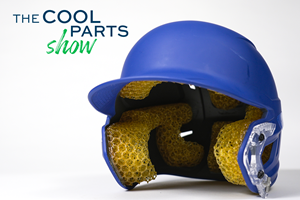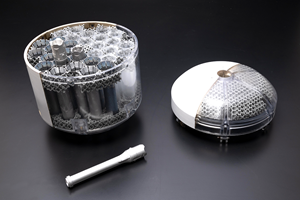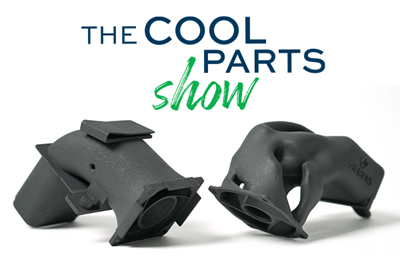Aircraft Ducts 3D Printed in Composite Instead of Metal: The Cool Parts Show #68
Eaton’s new reinforced PEKK, tailored to aircraft applications, provides a cheaper and faster way to make ducts compared to formed aluminum.
Share
Air handling ductwork in an aircraft has to meet many performance requirements at once. They include electrostatic resistance, flame resistance, chemical resistance and resistance to vibration, not to mention the requisite strength of the part — all in a form complex enough to snake around and through other elements of the aircraft. Formed aluminum ducts have satisfied the need historically, but Eaton’s Advanced Materials and Process Group is developing a different solution. With 3D printed polymer, ducts could be manufactured with less cost, less lead time, less part weight and more design freedom. The key is a polymer material satisfying all the design requirements. Eaton’s solution is a carbon-fiber-reinforced PEKK tailor-made by the company for this application. Watch this episode of The Cool Parts Show to learn how Eaton is preparing for the future of aircraft duct production. | This episode of The Cool Parts Show is sponsored by Carpenter Additive
The Cool Parts Show is a video series from Additive Manufacturing Media that explores the what, how and why of unusual 3D printed parts. Watch more here.
Have a cool part to share? Email us.
Welcome! You’ve unlocked premium content.
Related Resources
- An existing Eaton success with AM for part production: 3D printing metal aircraft parts.
- PEKK, PEEK, and the differences between these polymer materials.
- Pellet-fed Titan 3D printer from 3D Systems.
- Another duct made through 3D printing — this one optimized for air flow.
- 3D printed polymer replacing metal in a bracket for a helicopter.
Transcript
Stephanie Hendrixson
Today on the show, we're going to be talking about this polymer composite air duct.
Peter Zelinski
So this is an air duct for an aircraft. Airplanes have HVAC systems. This is a duct that is in some ways a lot like the air ducts you have in your home. And in other ways, it's a lot different. Because of the requirements for a duct that has to perform well and safely inside an airplane. Requirements related to strength and flammability just to name a couple. A duct section like this is often usually made of metal, made of aluminum, but this one is made of polymer composite. It was 3D printed by Eaton.
Stephanie Hendrixson
So Eaton is a large contract manufacturer. They serve a number of different industries, one of which is aerospace, and they've been using additive manufacturing for a long time for things like functional prototyping. But that's not what this is. This is a representation of a real air duct that would go into a real aircraft that is now being made through large-format additive manufacturing.
Peter Zelinski
Eaton is increasingly relying on additive manufacturing as a means of production. We've reported on this. Not too long ago, we visited a facility in South Carolina, an Eaton facility using additive manufacturing capacity to produce fuel system components for aircraft. This is a different opportunity. This is polymer replacing metal for additive manufacturing of air ducts. Eaton has a materials development group that has created the material that now seems to promise to bring about a freer, more flexible way to manufacture aircraft duct sections.
Stephanie Hendrixson
More flexible, because parts like this would typically be made from sheet metal, from aluminum, you would have to bend it, form it, weld it together. There's a lot of steps just to get the shape that you want before you get to things like cleaning and finishing and other things that might have to happen here. And so Eaton was looking for a way to simplify the manufacturing of components like this. And so actually 3D printing was not the first place that that thinking led them.
Peter Zelinski
Yeah. To talk about that, here is Javed Mapkar. He is senior technical manager with the Advanced Materials and Processes Group of Eaton's Research lab in Southfield, Michigan.
Javed Mapkar, Eaton
So in 2015, 2016, we had a project with our aerospace team called Blow Molded Ducts to replace metallic ducts with polymer composite using blow molding. The technology was very good. We were able to address some of the parts, but then we realized that there were some limitations with blow molding. It can only be used for simple geometries. It cannot be used for parts which have rapid transition, such as the part that we are showing you, which is going from a bigger diameter to smaller diameter. And then for each different part, you need tooling. So for aerospace, where there is high mix, low volume, it becomes costly because of the tooling. That's where we realized there's an opportunity to look into an alternate technology.
Peter Zelinski
Javed was talking about rapid transitions. So we can see that in this part, the way that the cross-sectional shape of this part transitions rapidly from this broad rectangular form into this tighter circular form. Blow molding, it's a means of working with polymer that's kind of like blowing up a balloon. Air pressure is used to press the polymer film against the shape of the mold. So soft drink bottles are made that way and it might have been a way to make polymer duct sections. But yeah, these quick geometric transitions in a shape like this were challenging to do through blow molding. So Eaton discovered that it was constrained in the forms that it could design into the ducts.
Javed Mapkar, Eaton
At that time additive manufacturing, especially these open material printers, were coming. So we looked at additive manufacturing as a parallel path, and then we bought a $1,000 printer from the market and took one of the materials that we were developing for aerospace fuel tube. It was an ESD nylon, converted that into Filament and started printing with that. The initial results were very promising and we were able to basically put a business case and pitch to our management for seed funding.
Stephanie Hendrixson
So that nylon material that Javed mentioned, he said it's an ESD material. So that stands for electrostatic dissipative. ESD materials basically prevent static electricity by slowing down and grounding any electrical charges that are being built up. So that you don't get a spark. They're used to protect electronics to prevent ignition of flammable substances like, for instance, that aerospace fuel. They were using that ESD nylon to make these ducts initially. And it worked. And to some extent these ducts need sort of the same properties. They need those ESD properties as well. But at a certain point they realized that that material was not really optimized and they needed to develop a new novel material specifically targeted, specifically designed for 3D printed air ducts.
Peter Zelinski
A material they developed themselves. So the base material for this duct is PEKK, poly ether ketone ketone. We've done previous episodes involving 3D printing with PEKK. This PEKK in this duct, for added strength, is reinforced with microscopic carbon fiber filament. But there's a lot more going on here than that. This material is tuned for this application. To get into all of the requirements of a reinforced PEKK that can serve in this application, here's one other team member who's been involved with this project all along. This is Si Chen. She is a senior specialist engineer with a focus on polymer nanocomposites.
Si Chen, Eaton
When it comes to aerospace materials, there's a very extensive list of requirements you have. First of all, there is a V0 flame rating. That means that a flame must be extinguished within 10 seconds of a vertical surface. In addition to that, there things like chemical resistance, smoke and toxicity, flame resistance. So those are the general requirements of material we'll have to go through in addition to application specific requirements. Things like vibration handling, the specific strength requirements of the part that's going to go on the plane. All of those things you will need to look at when you're thinking about putting some materials on the airplane. So we wanted to look at a material that would satisfy all of those applications. In addition to being high performance at high temperature. So the material we developed is a PEKK nanocomposite. Nanocomposite is a material that has nano fillers. So when you think about composites, typically you have continuous carbon fiber composites. So that's a long strand of carbon fiber that is surrounded by epoxy. So in this case, nanomaterials is a filler that has a dimension in the nanoscale. It's specially developed for additive manufacturing. What that means, it has really good printability, it has a good melt strength, so it really holds its shape well while you're printing. So it is a high temperature, high performance material. We’re able to dial in the process really well to get really good interlayer adhesion and strength out of the parts. We can get about 60%, 60 to 65% of the Z strength when compared to XY. In addition to that, we also have tailored conductivity for the material. Depending on what your need is, for example, if you want an ESD material, then this material will satisfy that.
Stephanie Hendrixson
So getting the material right and in fact, inventing a new material was necessary to start printing these air ducts that would be suitable for use in aircraft. But there were some things to work out on the 3D printing side as well. So as Javed said earlier, this project started with a printer that cost about $1,000 and at a certain point they needed something that was more repeatable, more reliable and a lot bigger to do the things that they wanted to do. So this air duct was made on a Titan Pellet 3D printer from 3D Systems.
Si Chen, Eaton
The machine we’re currently printing with is the 3D Systems Titan Pellet Printer. Like the name suggests, it’s a pellet printer. So we specifically chose the pellet piece of it because, one, you can directly print with pellets, so it's lower cause it's faster, there's less processing on the raw material side that's needed. And also with the type of parts that we're looking at, we wanted large parts. So pellet printing allows us to have that build volume that some of the SLS or FDM may not support. There's also the speed. So for a pellet printing, you can move a lot more material through on a per hour basis compared to SLS and FDM. All those things considered, we did a pretty thorough market analysis at the time when we were looking at the machine, and one of the key things that we were looking at was manufacturing maturity. So we wanted to look at a machine that has that focus in repeatability of the parts and Titan and 3D Systems at the time had the best on the market. So that's why we went with that. And so far we've been very happy with it.
Peter Zelinski
A lot of extrusion 3D printers use material in the form of a filament. The pellet material is easier to work with in formulation. Eaton formulates its own material on site at the same Michigan location where this 3D printing is being done. But more importantly, Eaton is going to produce big Duct sections like this is a pretty big 3D printed part, but this is a duct that is even bigger. And duct components like this are headed toward production, headed toward 3D printing at production speed and production quantities. So anticipating all of that, Eaton needs to think about the kind of 3D printing platform that can keep pace with that demand.
Javed Mapkar, Eaton
There are bigger parts with multiple transitions, but we can print them in less than 12 hours in one go. So there is shorter lead time, there is less post-processing. You don't need to do all the cleaning and other things. For this, ESD PEKK material, we are trying to qualify that with NIAR from Wichita State University for B basis allowable. So that way the material will be qualified with the 3D Systems Titan printer for aerospace application. So that's our focus. For that we need to make multiple batches of the material, print on multiple different printers, and show repeatability. So that will give us confidence to our customers who want to work with us that this material has all the right requirements.
Stephanie Hendrixson
All right. I think we got this.
Peter Zelinski
This is an aircraft duct section, part of the HVAC system for an airplane. Normally a part like this would be made out of formed aluminum. This is made out of reinforced polymer composite, made out of a special PEKK based material that was created by Eaton.
Stephanie Hendrixson
Eaton decided to pursue 3D printed air ducts because they were looking for a faster and more flexible way of producing these components. Getting to this point has involved developing their own novel material for this application, as well as working on the print parameters and doing a lot of development to optimize the whole process for these parts. There's more work to do. They're working on qualification right now, but they see a lot of promise in 3D printed polymer air ducts as a replacement for a formed aluminum.
Peter Zelinski
Javed and Si had more to say about that promise. Our All Access newsletter subscribers got to see an extra video segment where Javed and Si talked about the future of the 3D printing platform and the kind of 3D printing advances they're looking for that is going to take this work to the next step. You can see that video too. Just sign up for our All Access newsletter.
Related Content
How 3D Printing Aids Sustainability for Semiconductor Equipment: The Cool Parts Show Bonus
Hittech worked with its customer to replace fully machined semiconductor trays with trays made via DED by Norsk Titanium. The result is dramatic savings in tool consumption and material waste.
Read More3D Printed Lattices Replace Foam for Customized Helmet Padding: The Cool Parts Show #62
“Digital materials” resulting from engineered flexible polymer structures made through additive manufacturing are tunable to the application and can be tailored to the head of the wearer.
Read MoreFDA-Approved Spine Implant Made with PEEK: The Cool Parts Show #63
Curiteva now manufactures these cervical spine implants using an unusual 3D printing method: fused strand deposition. Learn how the process works and why it’s a good pairing with PEEK in this episode of The Cool Parts Show.
Read More3D Printed Lattice for Mars Sample Return Crash Landing: The Cool Parts Show Bonus
NASA Jet Propulsion Laboratory employs laser powder bed fusion additive manufacturing plus chemical etching to create strong, lightweight lattice structures optimized to protect rock samples from Mars during their violent arrival on earth.
Read MoreRead Next
Understanding PEKK and PEEK for 3D Printing: The Cool Parts Show Bonus
Both materials offer properties desirable for medical implants, among other applications. In this bonus episode, hear more from Oxford Performance Materials and Curiteva about how these companies are applying PEKK and PEEK, respectively.
Read More3D Printed Air Duct Based on Fluid Dynamics: The Cool Parts Show #26
Air ducts are ubiquitous, but are they all as efficient as they need to be? Computational fluid dynamics informed the redesign of this 3D printed air duct — made to serve a 3D printer.
Read MoreQualification Today, Better Aircraft Tomorrow — Eaton’s Additive Manufacturing Strategy
The case for additive has been made, Eaton says. Now, the company is taking on qualification costs so it can convert aircraft parts made through casting to AM. The investment today will speed qualification of the 3D printed parts of the future, allowing design engineers to fully explore additive’s freedoms.
Read More















